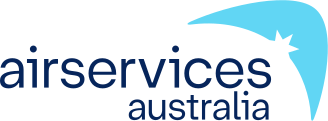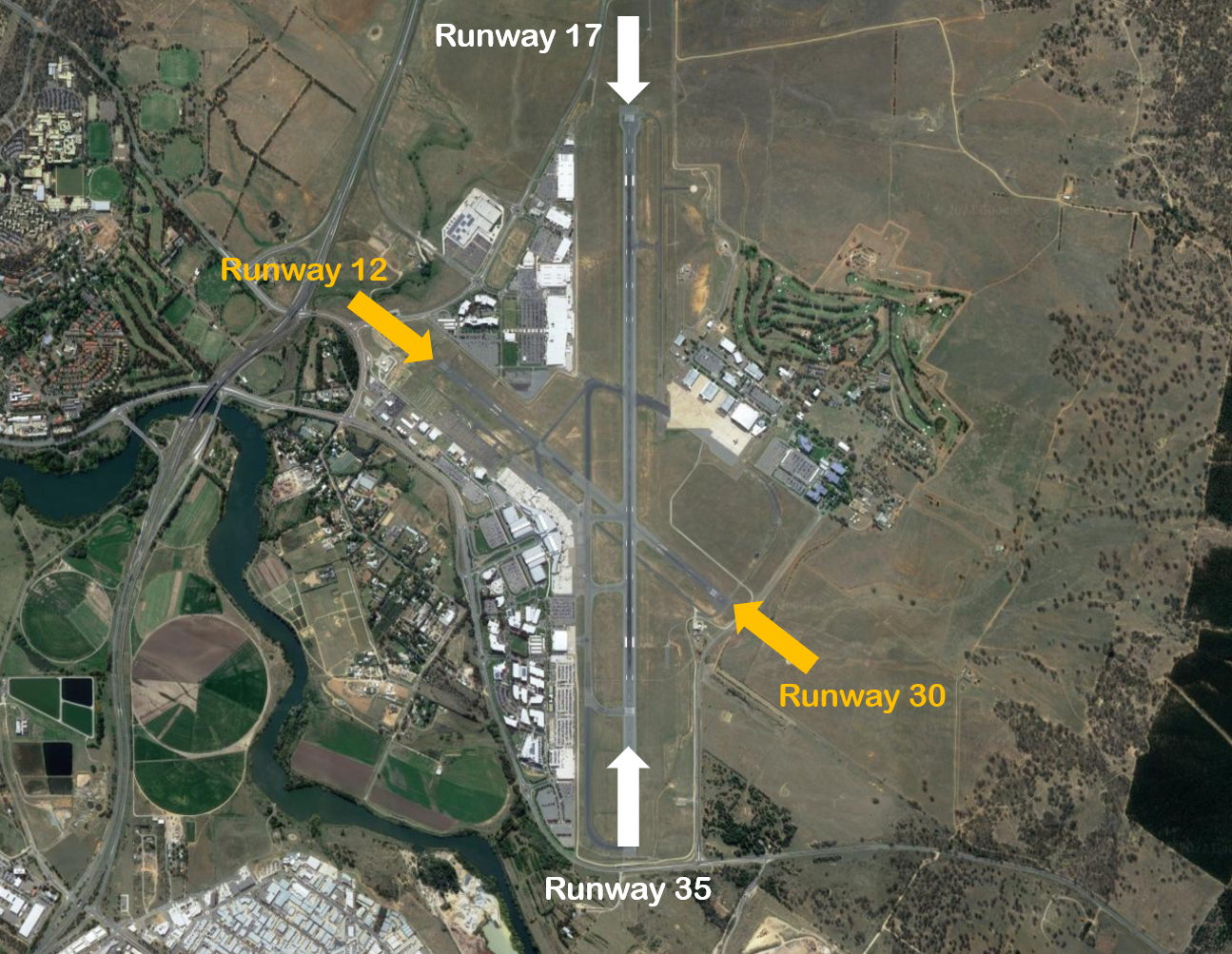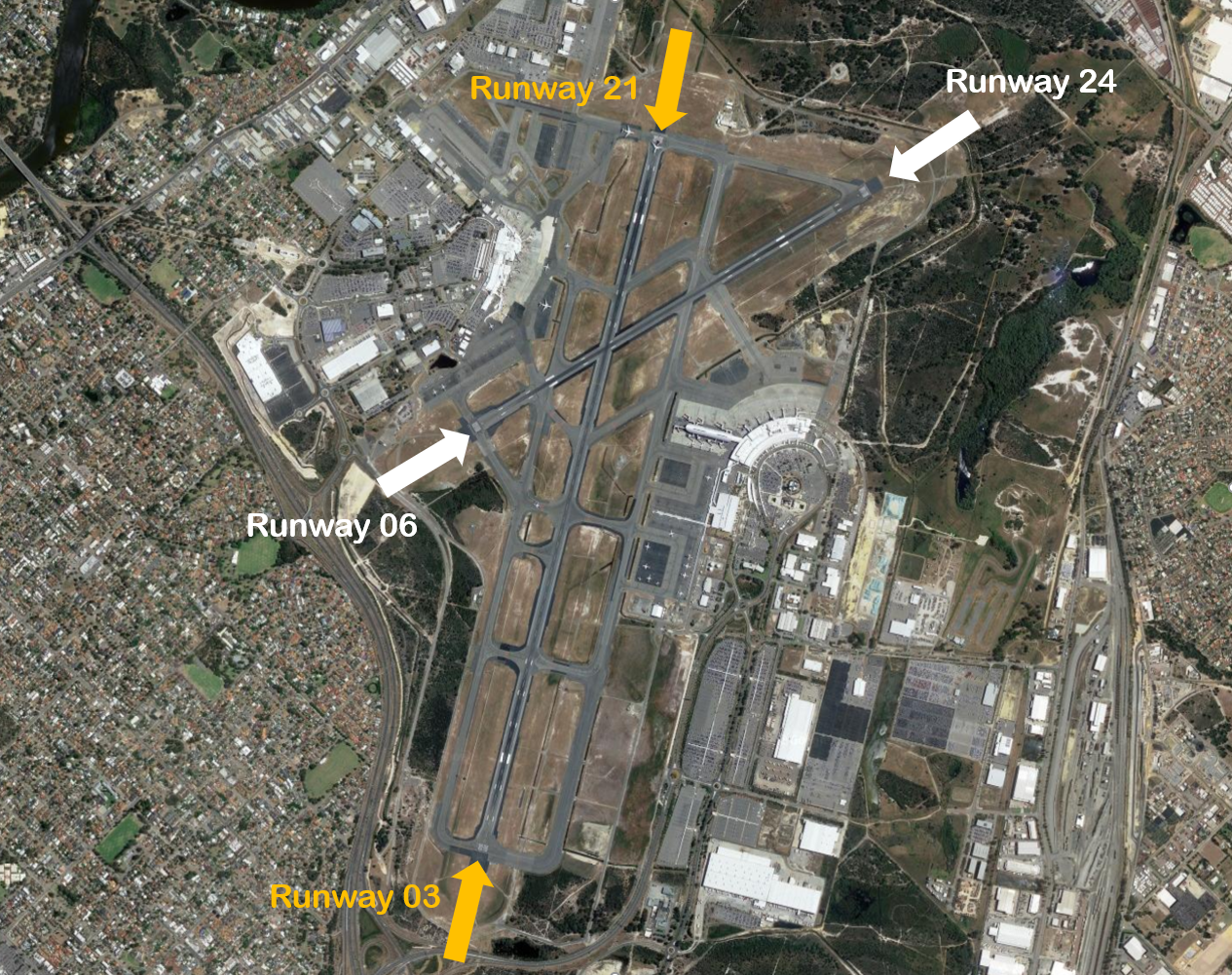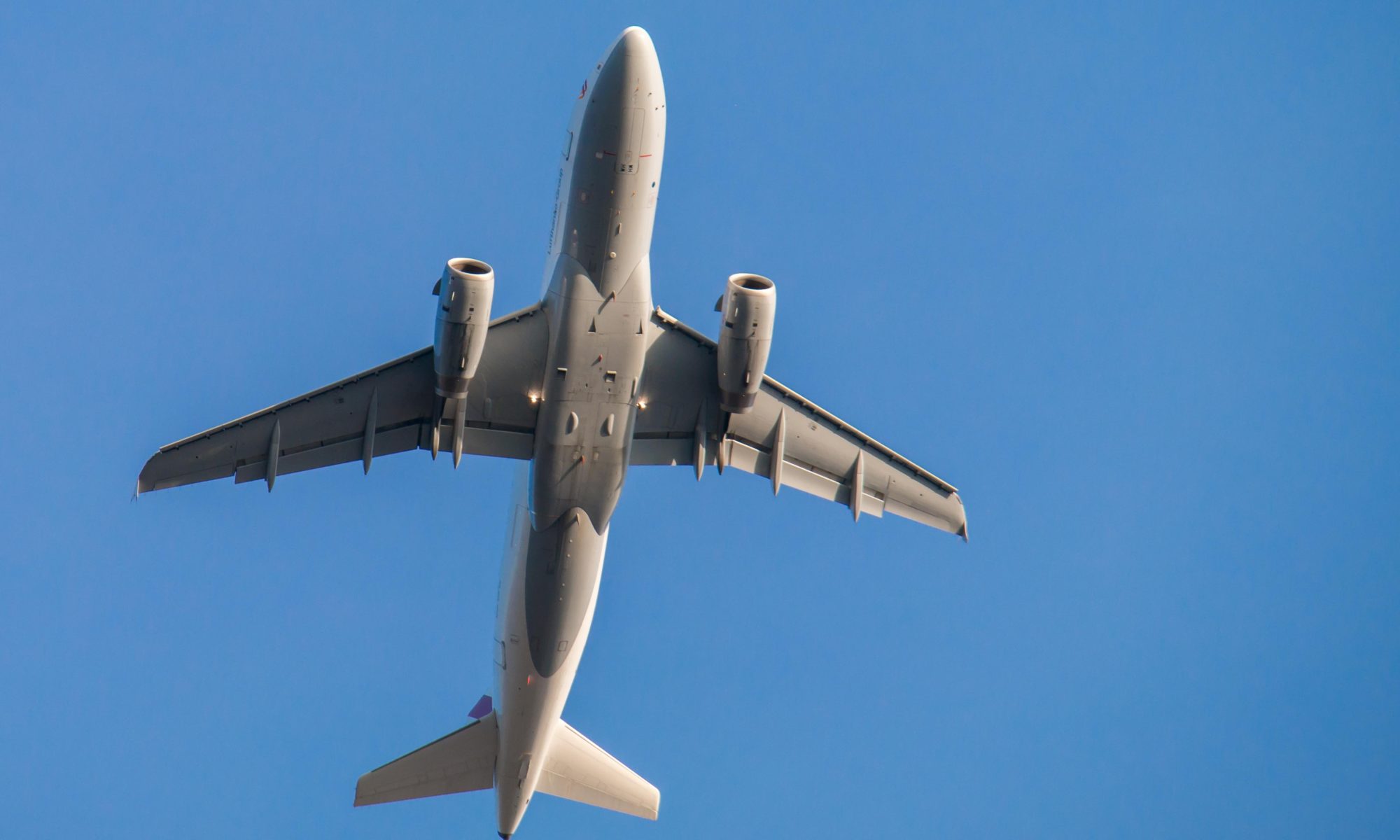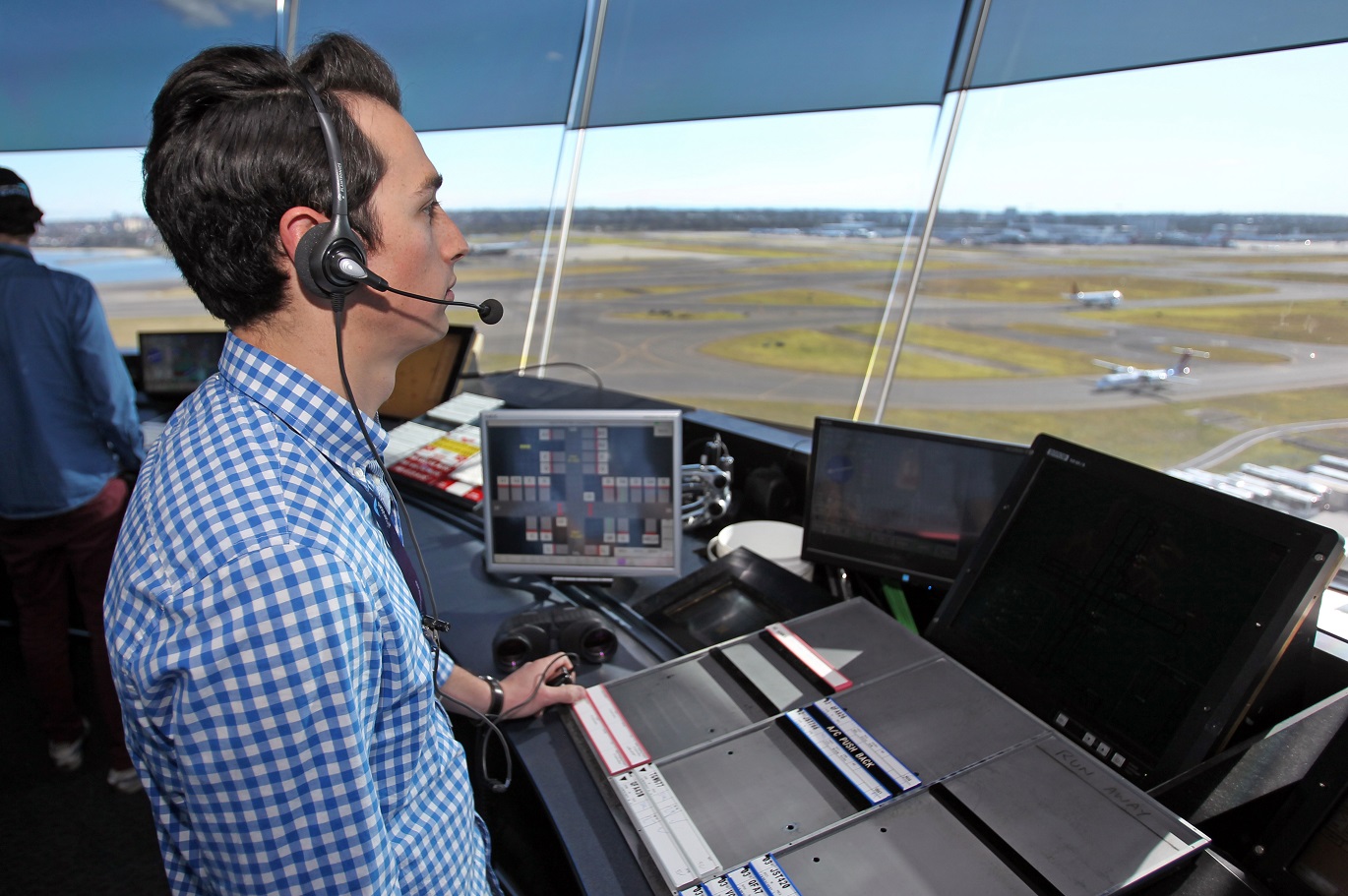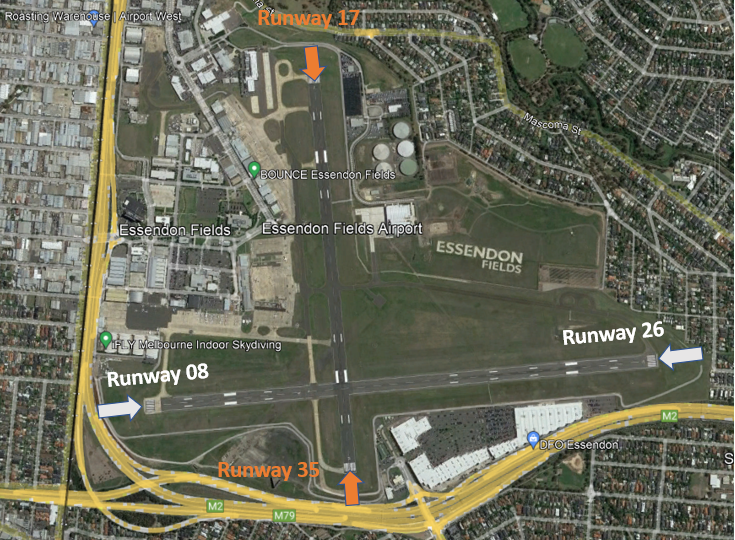The purpose of this review is to summarise Airservices investigation into community-initiated proposals for changes for flight paths to and from the south of Gold Coast Airport (‘Southern Operations’).
Canberra Airport Runways
Canberra Airport has two runways; the main runway 17/35 (3.28 km long) is orientated north-south and is used for the majority of aircraft traffic. The shorter runway 12/30 (1.67km) is orientated east-west and is used mainly for propeller aircraft.
Each runway is referred to differently according to in which direction it is being used. For example the main runway is known as Runway 35 when used in a northerly direction and Runway 17 when used in a southerly direction. Runway numbering reflects the runways’ orientation and correlates with degrees on a compass. Runway 35 is 350 degrees.
An Instrument Landing System operates for aircraft landing on Runway 35, and Smart Tracking procedures are available for aircraft landing on Runways 35 and 17.
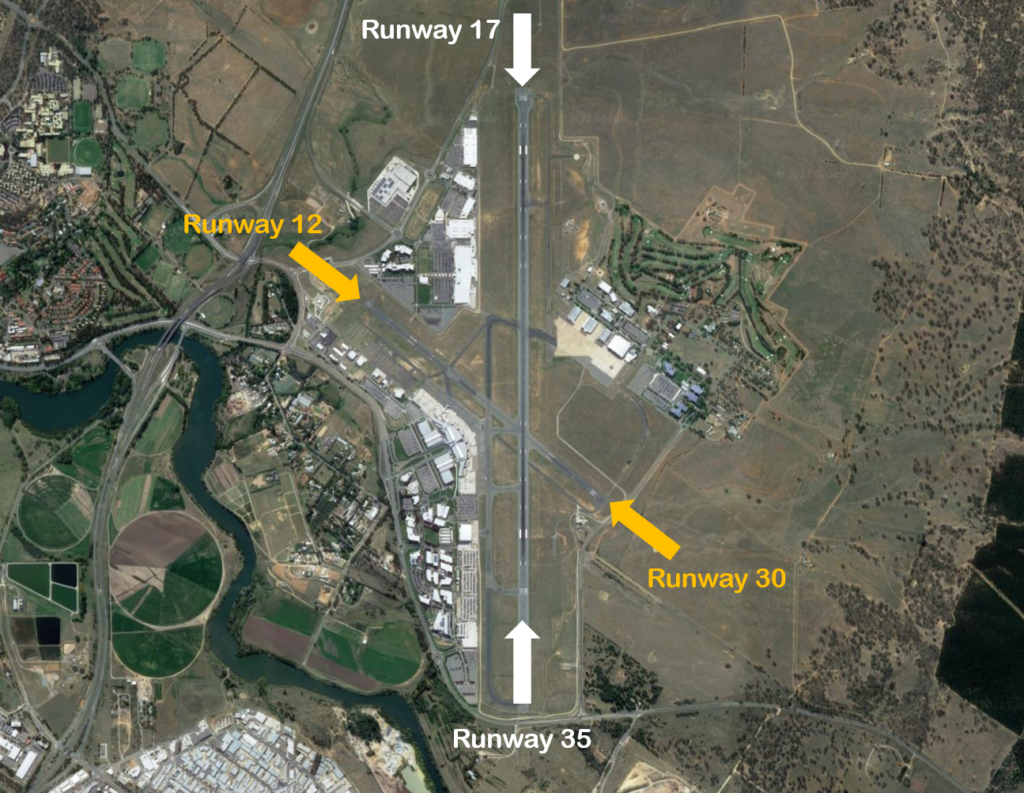
The following video explains how runways are named and used.
Runway selection and seasonal winds
Runway selection is based on wind direction, weather conditions, traffic volume and other factors. Aircraft primarily take-off and land into the wind for safety and performance reasons. Therefore, as the wind direction changes the runway in operation may also change depending on the strength of the wind.
This means that Canberra’s seasonal wind patterns affect usage of the different runway directions. The prevailing winds favour Runway 35 which is used more than 70 per cent of the time. Runway 17 tends to be used more frequently in the warmer months than at other times, but this does vary.
Noise abatement procedures
A noise abatement area applies to most residential areas of Canberra and Queanbeyan. Aircraft will normally be routed to avoid the noise abatement area, which covers most of Gungahlin, North Canberra, Belconnen, South Canberra, Woden, Tuggeranong and Queanbeyan. Where it is not practical for aircraft to remain clear of those areas, during overflight jet aircraft must not fly below 7 000 feet above ground level and large propeller aircraft not below 5 000 feet. Smaller propeller aircraft are permitted. A number of exceptions apply to the noise abatement areas such as aircraft emergencies, medical priority flights, avoidance of hazardous weather, missed approaches and operational requirements.
Perth Airport Runways
Perth Airport has two runways; the main runway 03/21 (3.4 km long) is orientated approximately north-south and the smaller cross runway 06/24 (2.2km) is orientated south-west to north-east.
Each runway is referred to differently according to in which direction it is being used. For example the main runway is known as Runway 03 when used in a northerly direction and Runway 21 when used in a southerly direction. Runway numbering reflects the runways’ orientation and correlates with degrees on a compass. Runway 21 is 210 degrees.
An Instrument Landing System operates for aircraft landing on Runways 03,21 and 24, and non-precision approaches are available to all runways.
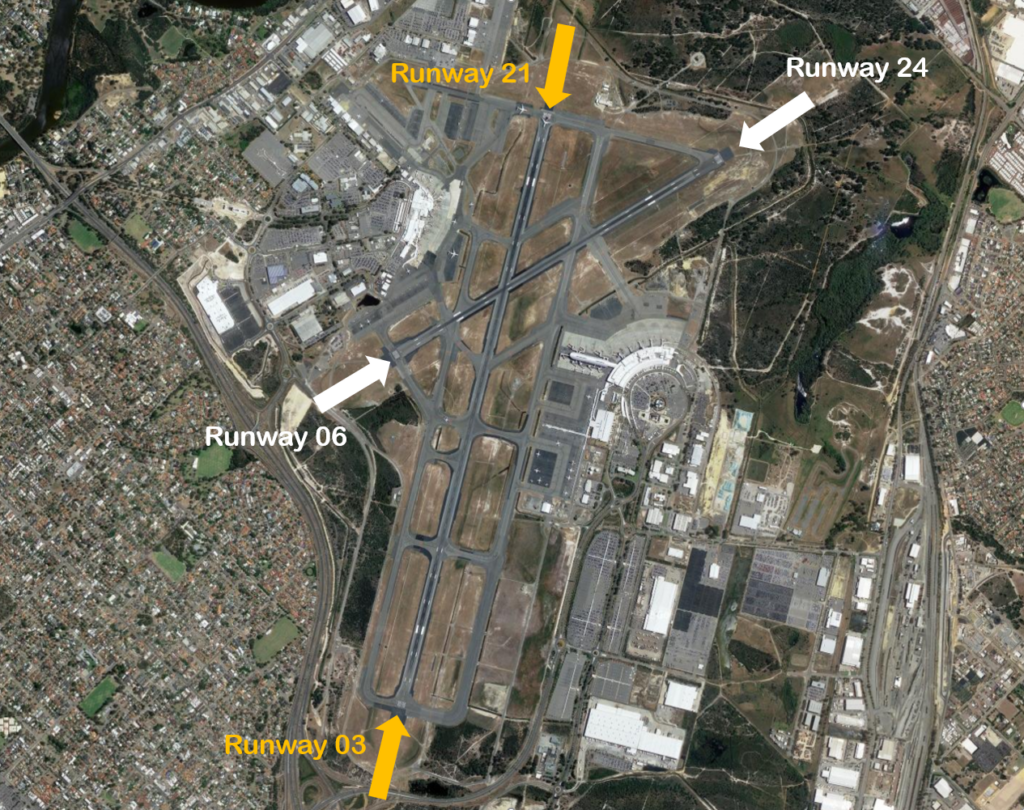
The following video explains how runways are named and used.
Runway selection and seasonal winds
Runway selection is based on wind direction, weather conditions, traffic volume and other factors. Aircraft primarily take-off and land into the wind for safety and performance reasons. Therefore, as the wind direction changes the runway in operation may also change depending on the strength of the wind.
This means that Perth’s seasonal wind patterns affect usage of the different runway directions. Specifically, Runway 21 tends to be used more frequently in the warmer months due to southerly winds whereas Runway 03 tends to be used more frequently in the cooler months when the predominant wind direction tends to be northerly.
Runways may be used in combination. For example, Runways 03 and 06 may be used at the same time for departures, or Runways 21 and 24 may be used at the same time for arrivals.
Runway use in peak periods
One of the factors taken into account in runway selection is operational requirements. For example, two operational factors make Runway 21 a more suitable choice for departures during peak periods. Firstly, the location of the terminals and hangars in relation to the runways means that departing aircraft can be moved to Runway 21 more efficiently than to other runways. Secondly, because there is so much military restricted airspace to the north of Perth Airport, there is more airspace available to the south in which to manage the mix of slow and fast aircraft in the air after departure. Both these factors become critically important when the volume of traffic is high. For these reasons, Runway 21 will usually be selected in peak periods if the wind allows it. Therefore it can be expected that Runway 21 will be used whenever possible for the morning departure burst which is the busiest period at Perth Airport. This begins around 5 am.
Noise abatement procedures
Noise abatement procedures are designed to help reduce the impact of aircraft noise on communities. While they are applied whenever it is possible to do so, their use is not mandatory and is subject to weather conditions and traffic requirements.
The Perth Noise Abatement Procedures state that Runways 03, 21 and 24 are equally preferred for arrivals. For departures, Runways 03, 21 and 06 are equally preferred. Movements over the south-western end of the crossing runway that is, arrivals to Runway 06 and departures from Runway 24, are least preferred under the procedures. This is due to the very close proximity of residential areas to this end of the crossing runway. This runway end is used on occasion however, for example when there is too much crosswind to use the main runway, and when the main runway is unavailable for reasons such as runway works.
The procedures also provide that:
- aircraft departing towards the north and turning east of Perth are to be kept on the Standard Instrument Departure track until leaving 8000 feet, unless there is an operational reason not to do so
- departing aircraft will usually be given a Standard Instrument Departure (SID) but where this is not possible the route given will approximate the SID as closely as possible
- arriving aircraft flying under instrument flight rules (IFR) must be given Standard Arrival Routes (STAR) where available. Any non-STAR tracking must approximate the STAR as closely as possible except in some specific circumstances
Perth Airport Flight Paths
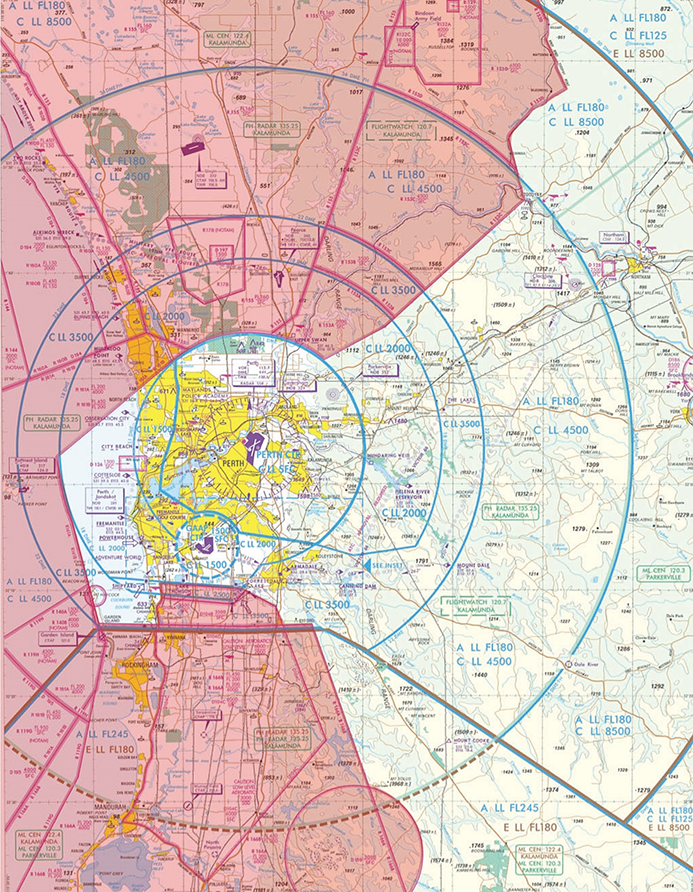
Flight paths for Perth Airport are designed around military airspace to the north, west and south, and Jandakot Airport airspace to the south. Military restricted areas are shown in pink in the image at right. Click to enlarge and use your back button to return to this page.
Military airspace
Military airspace (see image at right) can be active to ground level or it can begin at a certain altitude. Some military airspace is active only at certain times of the day and week. Where possible, flight paths are designed to remain under military airspace or to fly over the top of it. The close proximity of RAAF Base Pearce to the north means that air traffic controllers at Perth Airport have to coordinate their actions with RAAF controllers, including for changes of runway direction.
Flight path information
You can access historical information about flight path use through WebTrak. To access this information click the “Historical” link below the text in the Quick Start Guide at the top left-hand side of the screen. Then use the tick boxes at the bottom-right of the screen to select monthly, quarterly or yearly information. Use the sliders to refine your selection to specific timeframes.
To learn more about the runway at Perth Airport, take a look at our Perth Airport Runway page.
The illustration below shows how jet and non-jet (turbo-prop) aircraft typically operate at Perth Airport on the published instrument arrival and departure flight paths.
The animation is indicative only and provided for information purposes, on occasions flights may leave these general areas from time-to-time.
Canberra Airport Flight Paths
Canberra Airport has a number of flight paths from its runway.
To learn more about the runway at Canberra Airport, take a look at our Canberra Airport Runway page.
The illustration below shows how jet and non-jet (turbo-prop) aircraft typically operate at Canberra Airport on the published instrument arrival and departure flight paths.
The animation is indicative only and provided for information purposes, on occasions flights may leave these general areas from time-to-time.
When is each flight path used?
Flight paths are not precise, defined paths like runways, but more like corridors that are often several kilometres wide.
Arrivals
Arriving aircraft will line up with the runway centreline and fly straight in on the runway heading. Aircraft will approach Canberra from all directions before they join the final approach path. Jet aircraft will join the final approach between 15 and 25 kilometres from Canberra Airport and fly towards the runway in a straight line. Jet aircraft will generally be at altitudes from 3000 to 4000 feet when they join the final approach. There is no minimum altitude for aircraft in the process of landing. Aircraft will generally descend on a glide slope of three degrees.
Departures
Departing jets will generally maintain a straight line from the runway for around 15 kilometres before turning to their heading.
The altitude of aircraft after departure will depend on factors such as the type of aircraft and its weight, how heavily laden it is with fuel and passengers, and the atmospheric conditions at the time. All these factors affect an aircraft’s climb rate. There is no regulated minimum altitude for an aircraft in the process of taking off.
Smart Tracking
A growing number of modern aircraft are now fitted with navigation systems that use satellite-assisted guidance which allow aircraft to fly with a higher degree of accuracy and more closely follow the same route as other aircraft. Airservices refers to these routes as ‘Smart Tracking’. Smart Tracking technology makes air travel safer, cleaner and more dependable. It also has the potential to improve noise outcomes for communities living close to airports.
Flight path information
You can access historical information about flight path use through WebTrak. To access this information click the “Historical” link below the text in the Quick Start Guide at the top left-hand side of the screen. Then use the tick boxes at the bottom-right of the screen to select monthly, quarterly or yearly information. Use the sliders to refine your selection to specific timeframes.
When is each flight path used?
Flight paths are not precise, defined paths like runways, but more like corridors that are often several kilometres wide.
Arrivals
Jet arrivals into Perth are generally aligned with the runway at least ten kilometres from the airport. From this point they will fly towards the runway in a straight line. This means that suburbs in line with the runways are overflown by arriving jets. Other suburbs may be overflown by aircraft proceeding towards the point at which they join the final approach and align with the runway.
Runways 03, 21 and 24 have Instrument Landing Systems. This type of approach requires aircraft to be at around 3000 feet when they begin their approach. Aircraft will descend steadily to the runway using the horizontal and vertical guidance provided by the system.
There is no minimum altitude for aircraft in process of landing. Aircraft will generally descend on a glide slope of three degrees.
A growing number of modern aircraft are now fitted with navigation systems that use satellite-assisted guidance which allow aircraft to fly with a higher degree of accuracy and more closely follow the same route as other aircraft. Airservices refers to these routes as Smart Tracking. Smart Tracking technology makes air travel safer, cleaner and more dependable. It also has the potential to improve noise outcomes for communities living close to airports. A Smart Tracking approach was implemented to Runway 03 in 2015.
Departures
Departure flight paths allow aircraft to maintain the runway heading for a short time until they are stabilised in flight, and then to turn towards the route that will take them to their destination.
Around 60 per cent of all departures from Perth Airport depart to the south from Runway 21. Nearly two-thirds of this 60 per cent are heading for the eastern states and international ports such as New Zealand. These flights will turn left (east) from Runway 21. Around 40 per cent of this 60 per cent are aircraft heading for destinations to the west, north and north-west such as South Africa, the Middle East, Asia, Karratha, Paraburdoo and Port Hedland. These aircraft will turn right (west) after departure from Runway 21.
When Runway 03 is in use aircraft with westerly and northerly destinations will turn left. Some will continue northwards if military airspace is not active. Runway 03 is often used in combination with Runway 06, that is, both runways will be in use for departures at the one time. This means that air traffic controllers can only turn aircraft departing from Runway 03 right if it will not conflict with traffic departing Runway 06. When Runway 06 is used for departures, most of the domestic traffic to the eastern states will use that runway which minimises the need for aircraft to turn right from Runway 03.
The altitude of aircraft after departure will depend on factors such as the type of aircraft and its weight, how heavily laden it is with fuel and passengers, and the atmospheric conditions at the time. All these factors affect an aircraft’s climb rate. There is no regulated minimum altitude for an aircraft in the process of taking off.
Flight path information
You can access historical information about flight path use through WebTrak. To access this information click the “Historical” link below the text in the Quick Start Guide at the top left-hand side of the screen. Then use the tick boxes at the bottom-right of the screen to select monthly, quarterly or yearly information. Use the sliders to refine your selection to specific timeframes.
How many aircraft fly near me?
This tool shows the number of flights each day over your area in the selected month compared to the average for last year. The bottom axis shows the day of the month. Use the drop-down menu to change the selected month to see how movements have varied. Hover over each day to see flight numbers.
*Please note due to technical issues between 19 June and 22 June 2024, flight data may not be accurately displayed. Our supplier is working to resolve the issue. We apologise for any inconvenience this may cause.
How many aircraft fly near me?
This tool shows the number of flights each day over your area in the selected month compared to the average for last year. The bottom axis shows the day of the month. Use the drop-down menu to change the selected month to see how movements have varied. Hover over each day to see flight numbers.
*Please note due to technical issues between 19 June and 22 June 2024, flight data may not be accurately displayed. Our supplier is working to resolve the issue. We apologise for any inconvenience this may cause.
Jandakot Airport Runways
Jandakot Airport has three runways. A set of parallel runways, known as Runways 06 Left/24 Right and Runways 06 Right/24 Left are aligned approximately north-east to south-west. These runways are used for approximately 85 per cent of all movements. The alternate runway, Runway 12/30, is aligned approximately north-west to south-east.
Each runway is referred to differently according to in which direction it is being used. For example, the parallel runways are referred to as Runway 06 Left and Right when used in a north-easterly direction and Runway 24 Left and Right when used in a south-westerly direction.
Runway numbering reflects the runways’ orientation and correlates with degrees on a compass. Runway 06 is 60 degrees magnetic.

The following video explains how runways are named and used.
Runway selection and seasonal winds
Runway selection is based on wind direction, weather conditions, traffic volume and other factors. See the Runway Selection page for more details. Aircraft primarily take-off and land into the wind for safety and performance reasons. Therefore, as the wind direction changes the runway in operation may also change depending on the strength of the wind.
This means that Perth’s seasonal wind patterns affect usage of the different runway directions. For example, Runways 06 Left and Right tend to be used more often in the cooler months when there are frequent winds with a northerly component. Runways 24 Left and Right tend to be used more frequently in the warmer months when the predominant wind direction tends to be southerly.
Outside of Tower operating hours the pilot must determine the runway to be used based on the wind direction.
Noise abatement procedures
Noise abatement procedures are designed to help reduce the impact of aircraft noise on communities. While they are applied whenever it is possible to do so, their use is not mandatory and is subject to weather conditions and traffic requirements.
The preferred runways for circuit training are Runways 06 Right and 24 Left. This means that most of the aircraft undertaking circuit training operate to the south-east of the airport. There are also set hours for circuit training.
Runways 06 Left and 24 Right are the preferred runways for other arrivals and departures.
There are voluntary ‘Fly Neighbourly Agreements’ between airport management and aircraft operators. These are intended to minimise the impact of aircraft noise on the surrounding community. More information is available on the Jandakot Airport website.
The principles of these Fly Neighbourly Agreements are, whilst maintaining safety of operations, to:
- climb as soon as possible
- maintain height
- reduce engine revs as soon as possible
- follow designated flight paths
- avoid residential areas where possible
- not fly wide circuits unless required by air traffic control
